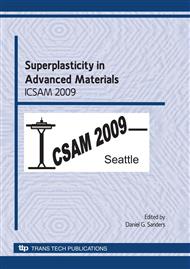p.291
p.299
p.305
p.311
p.319
p.325
p.333
p.339
p.345
High-Strain-Rate Superplastic Flow Mechanism in ZrO2-30vol% Spinel Two-Phase Composite
Abstract:
High-strain-rate superplasticity (HSRS) can be attained in tetragonal ZrO2-30vol% MgAl2O4 spinel composite. In order to examine the flow behavior of the two-phase composite, the standard rule of the mixture model was employed. The strain rate of the composite can be explained by the isostrain model that is predicted from the data set of Al2O3 doped ZrO2 and spinel polycrystals. For the isostrain model, since the strain and strain rate are the same for ZrO2 and spinel phases, the harder ZrO2 phase carries more of the stress in the composite. In order to preserve homogeneous deformation and material continuity, a concomitant accommodation process within the harder ZrO2 grains is also necessary. For HSRS in the ZrO2-spinel composite, therefore, the rate of deformation may be controlled by the slower dislocation recovery process limited by the lattice diffusion within harder ZrO2 grains rather than within spinel grains.
Info:
Periodical:
Pages:
333-338
Citation:
Online since:
March 2010
Authors:
Price:
Сopyright:
© 2010 Trans Tech Publications Ltd. All Rights Reserved
Share:
Citation:


